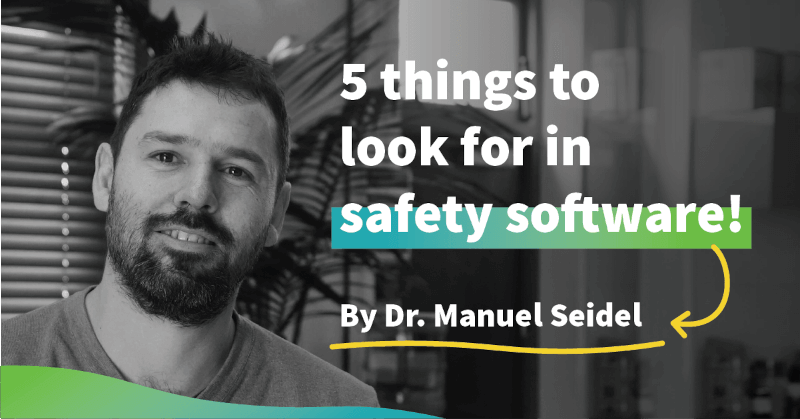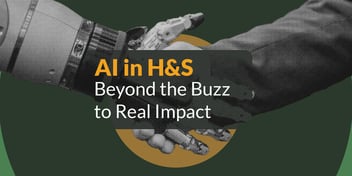Now more than ever, reducing risks and maintaining a culture of safety are sure-fire ways to improve health and safety performance – an integral part of long-term success. Harnessing the power of technology can make that faster and simpler.
When investing in safety software, there are a few key factors that organisations must consider if they’re to experience the optimal benefits or return on investment. Organisations first need to assess their context, which should provide a framework by which to choose the best option to support long-term health and safety goals.
If you are a larger company, you’ll need something that precisely meets your requirements. Whereas a medium-sized company is more likely to want something off the shelf, which follows best practice, is fast to implement, and doesn’t necessarily require internal resources to project-manage.
Once you understand the type of software your organisation requires, here are the top five elements you’ll want to consider:
Get fresh H&S insights weekly
Usability – bring health and safety to the people
Regardless of the health and safety system you use, staff engagement is the number-one success factor. You want to look for software that feels intuitive to use, even by people who aren’t comfortable with technology. It’s part of why we built ecoPortal – there’s no point in having an ISO 45001 certificate on the wall, if your health and safety management system isn’t helping you to reduce your risks.
Here’s what to consider when assessing usability:
Clean, modern interface: People are using modern and easy-to-use social media platforms and mobile apps at home and expect the same user experience for software systems they use at work. This will also allow them to get up to speed faster, without hours of training.
Matches UX to role in organisation: Not every user’s experience will be – or needs to be – the same. Look for safety software that lets you adjust the experience to suit different roles and permissions. For example, if team members only need to log incident reports, they only need access to that functionality.
Consistency of module design: The different modules, like logging an incident or conducting an audit, should all follow the same workflow. This means users can learn the process once and then apply it across other modules.
Configurability – make it your own
For larger companies, configuring a fit-for-purpose health and safety solution will enhance the user experience, productivity, and engagement.
Having the capability to tailor the system to align with the structure of your organisation ensures the right people get access to the right information. Making it look and feel like your system adds to the feeling of ownership for your people, too.
Look for systems that allow you to:
Customise language: Look for a solution that lets you adjust the terminology to align with your organisation or industry – or at least is simple enough that all users can confidently interact with the system.
Change the look and feel: Being able to use your brand colours to change the look and feel of the tool will give employees a feeling of ownership and improve engagement.
Focus on different metrics: Choose a tool that will let you zero in on the metrics you need to meet best-practice standards in your industry. Don’t over-complicate it with data you don’t need.
Accessibility – where will it be used
It’s a simple factor, but often overlooked – people need to be able to access the health and safety management software in a way that complements their role in the organisation.
Here are some accessibility factors to consider:
Types of devices: Different working environments will determine how your staff can access the system. You’ll need safety software that can be accessed on mobile devices for field workers, on kiosks for those without devices, and on a variety of web browsers to suit your desk-bound staff.
Ability to work offline: Even if employees generally only work online, check that they can still use the tool without an internet connection. It’s likely you’ll want a health and safety system that can work offline, so operations don’t come to a halt just because the internet is down.
Single sign-on capability: Remembering 20 different passwords for 20 different systems can become a barrier for interaction. Solve that with single sign-on capability – signing in once to access all modules. This offers staff a seamless experience, which means more people using it, and less administrative time for the organisation.
Integration – the big picture
The capacity to integrate systems comes with huge benefits – saved administrative time and more accurate and timely data.
Here are some of the systems your new health and safety management software should be able to integrate with:
Other risk-management systems: For many organisations, health and safety aren’t the only risks to manage. When your safety software can integrate with the wider system and other areas of risk, one workflow can cover multiple areas – making it simple to get a broader view.
For example, a chemical spill is both an environmental event if the spill goes down the drain and a health and safety risk if someone breathes in the toxic fumes.
Payroll and HR systems: Use a safety saftware solution with API, so you can streamline things like people and data management processes.
Between modules: Integration also refers to the relationship between different modules of the system, for example, incident or event management with your risk management, people, or actions modules.
A platform that allows you to integrate those different modules, creates a better-connected business, and you’ll be able to draw more usable insights out of your system.
Support – find a long-term software partner
While the software you choose is crucial to the success of your health and safety programme, your implementation partner is almost more important.
A truly effective health and safety management system not only understands organisational hazards and risks, but it also establishes – and maintains – a culture of safety that permeates throughout the entire organisation.
Organisations need to partner with a software company that has the capability and capacity to take care of onboarding effectively – as well as someone who isn’t afraid to push the technology frontier further when it comes to health and safety.
Your organisation will evolve, too – so it’s even more imperative you partner with a company that’s going to be with you in the long run.
We employ a whole team of full-time developers who are constantly evolving ecoPortal every day based on customer feedback. You want to find someone who is listening to their customers, partnering with them, and evolving their product all the time – like we do.
Whether you’re in the market for an out-of-the-box solution or an enterprise-level system with all the bells and whistles, ecoPortal has an option for your business. Try a demo or get in touch with the team at ecoPortal




.png?width=352&name=Blog%20hero%20image%202406%20(4).png)
.png?width=352&name=Verdantix%20GQ%20Blog%20(4).png)
tal%20health.png?width=352&name=Lets%20talk%20(men)tal%20health.png)

